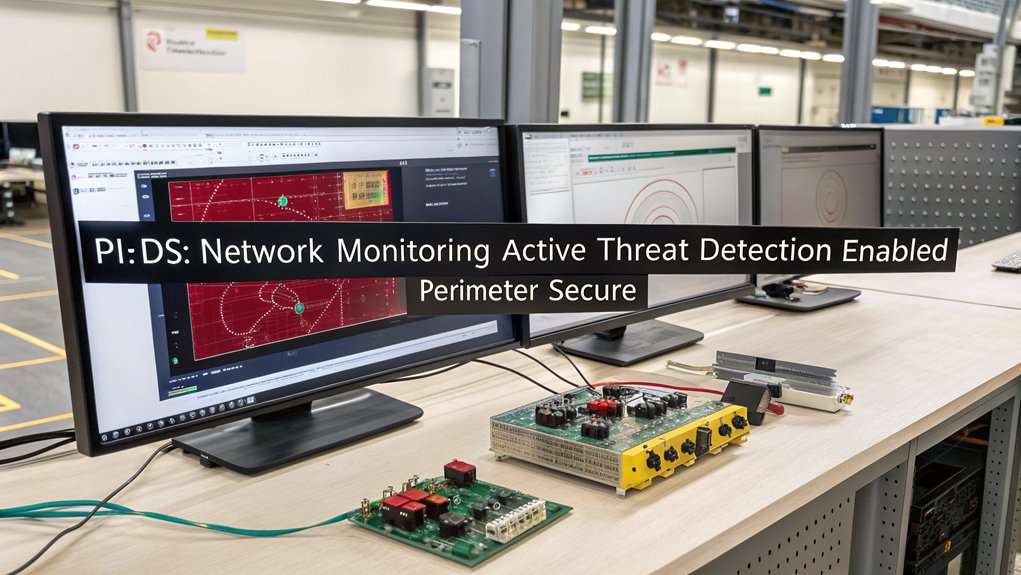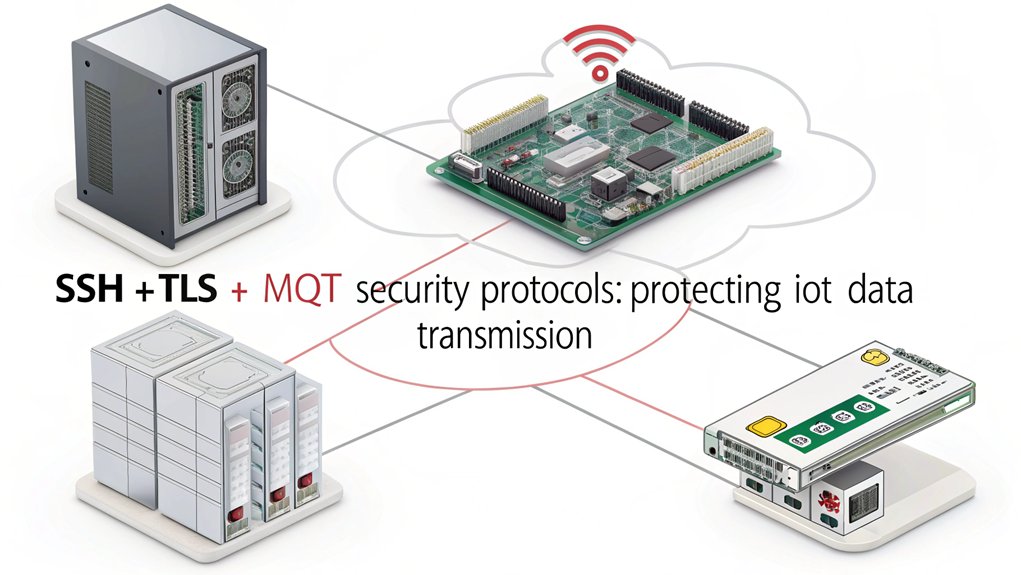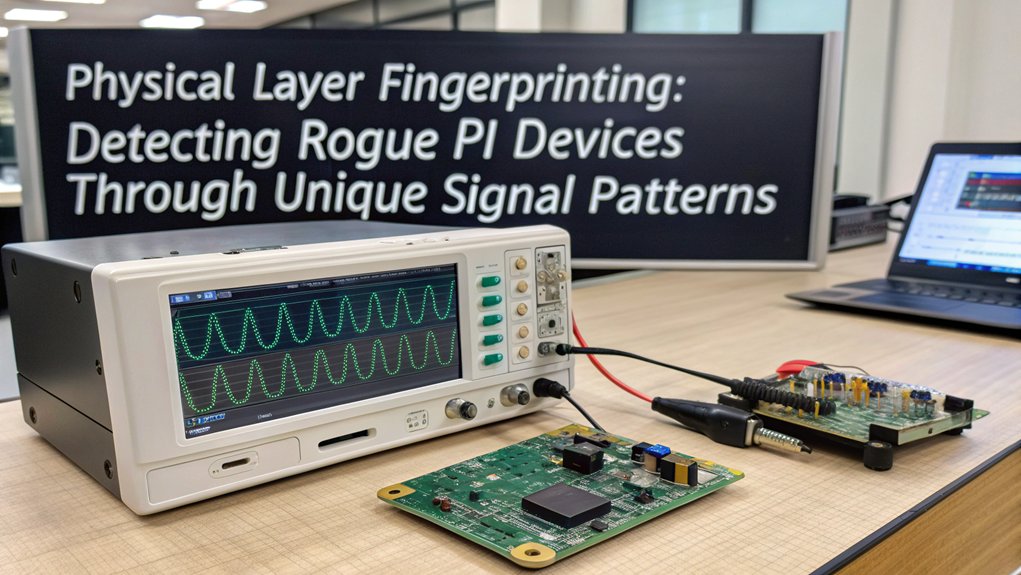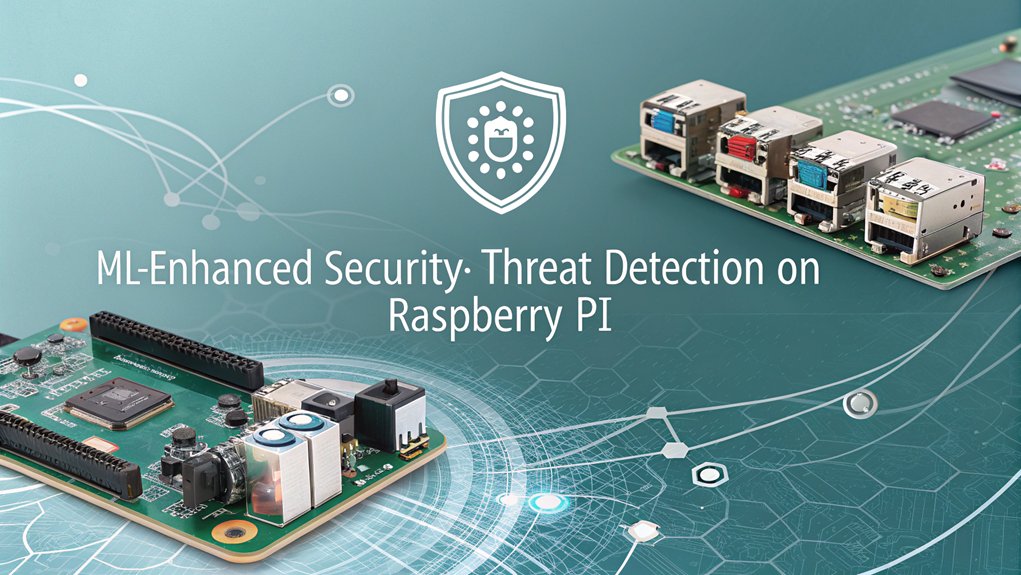Why Do You Need a Raspberry Pi for IoT Security?
Imagine discovering an unauthorized access attempt on your home automation system that went undetected for weeks. You’re not alone—IoT networks face increasingly sophisticated threats that traditional security measures often miss. Using a Raspberry Pi for IoT security offers a cost-effective foundation for building customized security solutions that protect your connected devices. From intrusion detection systems to encrypted communications and machine learning-based anomaly detection, these pocket-sized computers provide powerful tools to identify and neutralize threats before they compromise your IoT ecosystem.
Key Takeaways
- Raspberry Pi can function as a cost-effective network gateway with Snort or Suricata for real-time IoT traffic monitoring and threat detection.
- Deploy Pi.Alert on Raspberry Pi to instantly detect unauthorized devices on your IoT network with email notification capabilities.
- Implement machine learning models through Edge Impulse for anomaly detection and physical layer fingerprinting of potentially malicious devices.
- Secure remote IoT management using SSHv2 with key-based authentication on non-standard ports to prevent automated scanning attacks.
- Network segmentation via Raspberry Pi creates isolated IoT environments, significantly reducing vulnerability to external attacks while maintaining functionality.
Understanding Iot Security Vulnerabilities With Raspberry Pi
While IoT technologies continue to transform industries globally, Raspberry Pi deployments face an increasingly hostile threat landscape with over 50% of IoT devices containing critical security vulnerabilities. Your Pi-based systems are susceptible to exploitation through weak authentication protocols, default credentials, and inadequate firmware update processes. Software encryption alone provides insufficient protection as physical access vulnerabilities remain a significant security gap regardless of encryption strength. Regular analysis using network monitoring tools like Wireshark can help identify suspicious traffic patterns and potential breach attempts.
Conducting a thorough vulnerability assessment reveals common attack vectors: insecure APIs, insufficient encryption during data transmission, and poorly implemented access controls. These weaknesses are particularly concerning when deploying Raspberry Pi in healthcare or manufacturing environments where breaches can have cascading impacts.
Effective threat modeling must account for the limited processing capabilities of Pi devices while addressing the complexity of heterogeneous IoT networks. The 15% year-over-year increase in device risk necessitates strategic security planning for every connected component to prevent unauthorized access and protect sensitive operational data. Network segmentation is essential for Raspberry Pi implementations to ensure lateral movement prevention if a single device is compromised. The retail sector shows highest device risk compared to other industries, making security measures especially critical for Pi-based retail applications.
Building a Raspberry Pi-Based Intrusion Detection System

Building an effective defense against IoT security threats starts with implementing a Raspberry Pi-based intrusion detection system (IDS).
IoT defenses begin with a Raspberry Pi-powered intrusion detection system that monitors network traffic for suspicious activity.
You’ll need a Raspberry Pi 4 with at least 4GB RAM, running Raspberry Pi OS for peak performance.
Configure your Pi as a network gateway to enable thorough network monitoring. Install Snort or Suricata for real-time traffic analysis, and integrate Zeek for enhanced threat analysis capabilities. Setting up proper traffic policy enforcement helps protect your private network from unauthorized access and potential attacks.
Implement Pi.Alert to detect unauthorized devices instantly. Pi.Alert provides convenient email notifications when unknown devices connect to your network or when known devices go offline.
For advanced protection, incorporate machine learning algorithms like LSTM to identify anomalous traffic patterns. Train neural networks using datasets such as CSE-CIC-IDS 2018 to improve detection accuracy.
Maintain your system’s effectiveness by regularly updating IDS rules, implementing robust logging practices, and developing a response plan for security alerts. Install Nmap using apt-get package manager to scan for network vulnerabilities and identify open ports on your IoT devices.
Network segmentation further minimizes potential impact from identified threats. For enhanced security, consider implementing SSH key authentication instead of password-based login when accessing your IDS remotely.
Secure Communication Protocols for Raspberry Pi IoT Deployments

Securing data transmission between IoT devices represents a critical component of any robust Raspberry Pi deployment.
You’ll need to implement HTTPS and MQTT with dTLS for encrypted communication, especially in low-data-rate applications. These secure communication methods guarantee data remains protected during transit while authenticating its source.
For protocol implementation, prioritize SSHv2 for remote access, preferably with key-based authentication instead of passwords. Using non-standard ports for SSH access can effectively deter automated scanning attacks targeting default configurations. When working with local device connections, utilize common protocols like I2C and SPI for secure sensor communication.
Consider implementing network segmentation by creating dedicated IoT networks isolated from the internet. When configuring your devices, use MQTT with dTLS or HTTPS for data exchange, and IPsec for securing IP communications at the packet level. Network scanning tools like Nmap can help identify vulnerabilities in your IoT network infrastructure.
Regular security updates and audits will protect your Raspberry Pi deployment against emerging vulnerabilities, while monitoring tools like htop can help identify suspicious activity. Installing Fail2Ban tools can provide additional protection against brute force attacks on your IoT security system.
Physical Layer Fingerprinting to Prevent Rogue Raspberry Pi Attacks

Physical layer fingerprinting represents a cutting-edge approach to identifying and preventing rogue Raspberry Pi devices from infiltrating your IoT infrastructure. By analyzing device descriptors, this technology creates unique digital fingerprinting techniques that identify hardware at its most fundamental level.
When deployed, these systems compare device signatures against known malicious profiles, automatically blocking unauthorized Raspberry Pi devices that may be disguised as legitimate peripherals. This approach is essential because these miniature computers often evade traditional security measures by operating outside normal detection parameters. Similar to how unique fingerprints are used for biometric identification in security systems, each device has distinctive hardware characteristics that can be cataloged and verified. The danger is particularly severe as these devices can facilitate Advanced Persistent Threats against critical infrastructure.
Sepio’s implementation leverages machine learning to enhance rogue device detection, analyzing behavioral patterns alongside physical characteristics. Zero-trust policies should be implemented alongside network segmentation to isolate suspicious devices and prevent lateral movement within your IoT ecosystem.
You’ll gain thorough visibility into all hardware assets across your IT/OT/IoT environments, efficiently mitigating risks associated with covert implants. Traditional software security measures often fall short as they cannot detect physical tampering or unauthorized access to exposed ports like UART and GPIO. This technology guarantees your organization maintains regulatory compliance while strengthening your overall cybersecurity posture against sophisticated physical-layer attacks.
Machine Learning Approaches Enhancing Raspberry Pi for IoT Security

While traditional security measures provide baseline protection, machine learning approaches have revolutionized Raspberry Pi security implementation by enabling intelligent threat detection and response capabilities.
You can integrate Edge Impulse to rapidly deploy optimized ML models tailored for resource-constrained environments.
Implement anomaly detection algorithms to identify unusual patterns in IoT ecosystem data, potentially revealing security breaches before they escalate. By leveraging YOLOv5 or MobileNet models, you’ll enable real-time surveillance with immediate threat identification capabilities.
Predictive analytics further enhances your security posture by anticipating vulnerabilities based on historical data analysis.
Edge computing architecture processes security data locally, reducing latency and enabling instant responses to threats. This approach guarantees efficient resource utilization while maintaining robust intrusion detection systems that continuously adapt to evolving security challenges. Implement key-based authentication to significantly strengthen your remote access security posture. The 40-pin GPIO connector allows for integration of additional security sensors to further enhance threat detection capabilities. For cost-effective deployments, consider Pi Zero models that minimize expense while still providing essential security monitoring functionality. Testing and deploying your security models is streamlined with the Edge Impulse CLI which easily downloads and sets up detection servers.
Frequently Asked Questions
How Does a Raspberry Pi’s Power Consumption Affect Its Security Capabilities?
Your Raspberry Pi’s power consumption directly constrains security capabilities. You’ll need energy optimization strategies to balance resource-intensive security operations with power efficiency, ensuring reliable monitoring without compromising system integrity during extended deployments.
Can Raspberry Pi Security Solutions Be Integrated With Cloud Security Services?
With 70% of IoT deployments utilizing cloud services, you’ll find robust cloud integration options through AWS IoT Core, Azure IoT Hub, and Particle Cloud—all implementing advanced security protocols for encryption, authentication, and remote monitoring.
What Backup Options Exist if a Pi-Based Security System Fails?
You’ll need redundant systems with automatic failover strategies including SD card imaging, external storage backups, NAS integration, and off-site data replication to guarantee continuous security operations despite hardware failures.
How Do You Physically Secure a Raspberry Pi in Exposed Locations?
You’ll want tamper-proof metal enclosures with locking mechanisms for exposed locations. Select weatherproof mounting options that conceal wiring. Reinforced polycarbonate enclosure materials resist impact while maintaining thermal efficiency.
What Certifications or Compliance Standards Apply to Raspberry Pi Security Implementations?
You’ll need to meet certification standards like UL Cybersecurity Assurance Program and comply with frameworks including PSTI Act, NIST guidelines, and GDPR when implementing IoT security solutions.
How Can You Use a Raspberry Pi for IoT Security?
Your Raspberry Pi represents a robust resource for reinforcing rigorous IoT security requirements. By deploying dedicated detection systems, implementing impenetrable protocols, and leveraging learning algorithms, you’ll create extensive countermeasures against contemporary cyber challenges. Physical fingerprinting further fortifies your framework against fraudulent devices. When properly provisioned, your Pi provides powerful protection that’s particularly pertinent as pervasive penetration tactics persist in today’s threat landscape.

I am a retired software engineer with experience in a multitude of areas including managing AWS and VMWare development environments. I bought a relative a mini-PC a year ago and have become passionate about the technology and its potential to change how we deploy software.

